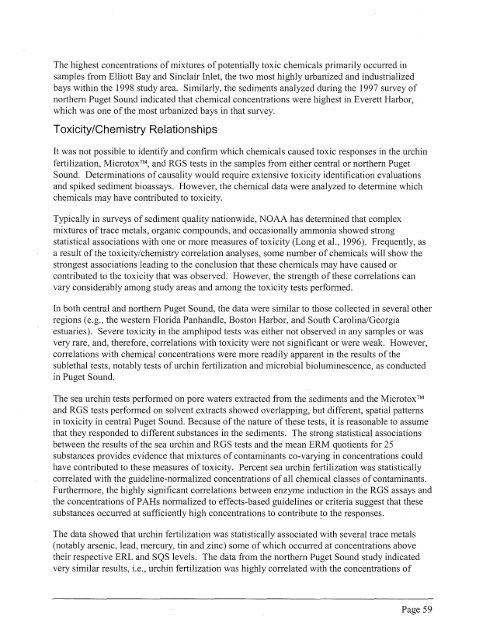Sediment Quality in Puget Sound Year 2 - Center for Coastal ...
Sediment Quality in Puget Sound Year 2 - Center for Coastal ...
Sediment Quality in Puget Sound Year 2 - Center for Coastal ...
Create successful ePaper yourself
Turn your PDF publications into a flip-book with our unique Google optimized e-Paper software.
The highest concentrations of mixtures of potentially toxic chemicals primarily occurred <strong>in</strong><br />
samples from Elliott Bay and S<strong>in</strong>clair Inlet, the two most highly urbanized and <strong>in</strong>dustrialized<br />
bays with<strong>in</strong> the 1998 study area. Similarly, the sediments analyzed dur<strong>in</strong>g the 1997 survey of<br />
northern <strong>Puget</strong> <strong>Sound</strong> <strong>in</strong>dicated that chemical concentrations were highest <strong>in</strong> Everett Harbor,<br />
which was one of the most urbanized bays <strong>in</strong> that survey.<br />
ToxicityIChemistry Relationships<br />
It was not possible to identify and confirm which chemicals caused toxic responses <strong>in</strong> the urch<strong>in</strong><br />
fertilization, MicrotoxTM, and RGS tests <strong>in</strong> the samples from either central or northern <strong>Puget</strong><br />
<strong>Sound</strong>. Determ<strong>in</strong>ations of causality would require extensive toxicity identification evaluations<br />
and spiked sediment bioassays. However, the chemical data were analyzed to determ<strong>in</strong>e which<br />
chemicals may have contributed to toxicity.<br />
Typically <strong>in</strong> surveys of sediment quality nationwide, NOAA has determ<strong>in</strong>ed that complex<br />
mixtures of trace metals, organic compounds, and occasionally ammonia showed strong<br />
statistical associations with one or more measures of toxicity (Long et al., 1996). Frequently, as<br />
a result of the toxicity/chemistry correlation analyses, some number of chemicals will show the<br />
strongest associations lead<strong>in</strong>g to the conclusion that these chemicals may have caused or<br />
contributed to the toxicity that was observed. However, the strength of these correlations can<br />
vary considerably among study areas and among the toxicity tests per<strong>for</strong>med.<br />
In both central and northern <strong>Puget</strong> <strong>Sound</strong>, the data were similar to those collected <strong>in</strong> several other<br />
regions (e.g., the western Florida Panhandle, Boston Harbor, and South Carol<strong>in</strong>aIGeorgia<br />
estuaries). Severe toxicity <strong>in</strong> the amphipod tests was either not observed <strong>in</strong> any samples or was<br />
very rare, and, there<strong>for</strong>e, correlations with toxicity were not significant or were weak. However,<br />
correlations with chemical concentrations were more readily apparent <strong>in</strong> the results of the<br />
sublethal tests, notably tests of urch<strong>in</strong> fertilization and microbial biolum<strong>in</strong>escence, as conducted<br />
<strong>in</strong> <strong>Puget</strong> <strong>Sound</strong>.<br />
The sea urch<strong>in</strong> tests per<strong>for</strong>med on pore waters extracted from the sediments and the MicrotoxTM<br />
and RGS tests per<strong>for</strong>med on solvent extracts showed overlapp<strong>in</strong>g, but different, spatial patterns<br />
<strong>in</strong> toxicity <strong>in</strong> central <strong>Puget</strong> <strong>Sound</strong>. Because of the nature of these tests, it is reasonable to assume<br />
that they responded to different substances <strong>in</strong> the sediments. The strong statistical associations<br />
between the results of the sea urch<strong>in</strong> and RGS tests and the mean ERA4 quotients <strong>for</strong> 25<br />
substances provides evidence that mixtures of contam<strong>in</strong>ants co-vary<strong>in</strong>g <strong>in</strong> concentrations could<br />
have contributed to these measures of toxicity. Percent sea urch<strong>in</strong> fertilization was statistically<br />
correlated with the guidel<strong>in</strong>e-normalized concentrations of all chemical classes of contam<strong>in</strong>ants.<br />
Furthermore, the highly significant correlations between enzyme <strong>in</strong>duction <strong>in</strong> the RGS assays and<br />
the concentrations of PAHs normalized to effects-based guidel<strong>in</strong>es or criteria suggest that these<br />
substances occurred at sufficiently high concentrations to contribute to the responses.<br />
The data showed that urch<strong>in</strong> fertilization was statistically associated with several trace metals<br />
(notably arsenic, lead, mercury, t<strong>in</strong> and z<strong>in</strong>c) some of which occurred at concentrations above<br />
their respective ERL and SQS levels. The data from the northern <strong>Puget</strong> <strong>Sound</strong> study <strong>in</strong>dicated<br />
very similar results, i.e., urch<strong>in</strong> fertilization was highly correlated with the concentrations of<br />
Page 59







